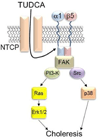Pharmacology of bile acid receptors: Evolution of bile acids from simple detergents to complex signaling molecules
- PMID: 26706784
- PMCID: PMC4900180
- DOI: 10.1016/j.phrs.2015.12.007
Pharmacology of bile acid receptors: Evolution of bile acids from simple detergents to complex signaling molecules
Abstract
For many years, bile acids were thought to only function as detergents which solubilize fats and facilitate the uptake of fat-soluble vitamins in the intestine. Many early observations; however, demonstrated that bile acids regulate more complex processes, such as bile acids synthesis and immune cell function through activation of signal transduction pathways. These studies were the first to suggest that receptors may exist for bile acids. Ultimately, seminal studies by many investigators led to the discovery of several bile acid-activated receptors including the farnesoid X receptor, the vitamin D receptor, the pregnane X receptor, TGR5, α5 β1 integrin, and sphingosine-1-phosphate receptor 2. Several of these receptors are expressed outside of the gastrointestinal system, indicating that bile acids may have diverse functions throughout the body. Characterization of the functions of these receptors over the last two decades has identified many important roles for these receptors in regulation of bile acid synthesis, transport, and detoxification; regulation of glucose utilization; regulation of fatty acid synthesis and oxidation; regulation of immune cell function; regulation of energy expenditure; and regulation of neural processes such as gastric motility. Through these many functions, bile acids regulate many aspects of digestion ranging from uptake of essential vitamins to proper utilization of nutrients. Accordingly, within a short time period, bile acids moved beyond simple detergents and into the realm of complex signaling molecules. Because of the important processes that bile acids regulate through activation of receptors, drugs that target these receptors are under development for the treatment of several diseases, including cholestatic liver disease and metabolic syndrome. In this review, we will describe the various bile acid receptors, the signal transduction pathways activated by these receptors, and briefly discuss the physiological processes that these receptors regulate.
Keywords: Bile acids; Farnesoid X receptor; Pregnane X receptor; Sphingosine-1-phosphate receptor 2; TGR5; Vitamin D receptor.
Copyright © 2015 Elsevier Ltd. All rights reserved.
Figures




Similar articles
-
The roles of bile acids and sphingosine-1-phosphate signaling in the hepatobiliary diseases.J Lipid Res. 2016 Sep;57(9):1636-43. doi: 10.1194/jlr.R069286. Epub 2016 Jul 26. J Lipid Res. 2016. PMID: 27459945 Free PMC article. Review.
-
Bile acids: regulation of synthesis.J Lipid Res. 2009 Oct;50(10):1955-66. doi: 10.1194/jlr.R900010-JLR200. Epub 2009 Apr 3. J Lipid Res. 2009. PMID: 19346330 Free PMC article. Review.
-
Bile acid receptors FXR and TGR5 signaling in fatty liver diseases and therapy.Am J Physiol Gastrointest Liver Physiol. 2020 Mar 1;318(3):G554-G573. doi: 10.1152/ajpgi.00223.2019. Epub 2020 Jan 27. Am J Physiol Gastrointest Liver Physiol. 2020. PMID: 31984784 Free PMC article. Review.
-
Bile acids, farnesoid X receptor, atherosclerosis and metabolic control.Curr Opin Lipidol. 2007 Jun;18(3):289-97. doi: 10.1097/MOL.0b013e3281338d08. Curr Opin Lipidol. 2007. PMID: 17495603 Review.
-
Bile acids as regulatory molecules.J Lipid Res. 2009 Aug;50(8):1509-20. doi: 10.1194/jlr.R900007-JLR200. Epub 2009 Apr 3. J Lipid Res. 2009. PMID: 19346331 Free PMC article. Review.
Cited by
-
Microwave-assisted green synthesis of bile acid derivatives and evaluation of glucocorticoid receptor binding.RSC Med Chem. 2020 Nov 19;12(2):278-287. doi: 10.1039/d0md00311e. eCollection 2021 Mar 4. RSC Med Chem. 2020. PMID: 34046616 Free PMC article.
-
Heterozygous knockout of Bile salt export pump ameliorates liver steatosis in mice fed a high-fat diet.PLoS One. 2020 Aug 12;15(8):e0234750. doi: 10.1371/journal.pone.0234750. eCollection 2020. PLoS One. 2020. PMID: 32785220 Free PMC article.
-
Microbial Metabolite Dysbiosis and Colorectal Cancer.Gut Liver. 2023 Mar 15;17(2):190-203. doi: 10.5009/gnl220260. Epub 2023 Jan 12. Gut Liver. 2023. PMID: 36632785 Free PMC article. Review.
-
Bile acids and their effects on diabetes.Front Med. 2018 Dec;12(6):608-623. doi: 10.1007/s11684-018-0644-x. Epub 2018 Oct 10. Front Med. 2018. PMID: 30306382 Review.
-
Serum bile acid patterns are associated with the presence of NAFLD in twins, and dose-dependent changes with increase in fibrosis stage in patients with biopsy-proven NAFLD.Aliment Pharmacol Ther. 2019 Jan;49(2):183-193. doi: 10.1111/apt.15035. Epub 2018 Dec 2. Aliment Pharmacol Ther. 2019. PMID: 30506692 Free PMC article.
References
Publication types
MeSH terms
Substances
Grants and funding
LinkOut - more resources
Full Text Sources
Other Literature Sources

